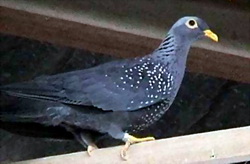African Olive-pigeon (Columba arquatrix) - Wiki African Olive-pigeon
From Wikipedia, the free encyclopedia
The African Olive Pigeon or Rameron Pigeon (Columba arquatrix) is a pigeon which is a resident breeding bird in much of eastern and southern Africa from Ethiopia to the Cape. There are also populations in western Angola, southwestern Arabia and northern Yemen. It is locally common, although there are sizeable gaps in its distribution due to its habitat requirements.
This is a species of moist forest canopies above 1400 m altitude, although it occurs locally as low as 700 m. It will use mountain fynbos, second growth and clearings, and feed on agricultural land if it is not persecuted
The African Olive Pigeon builds a large stick nest up to 15 m high in a tree and lays one (rarely two) white eggs. The eggs are incubated for 17-20 days to hatching, and the chicks fledge in another 20 days.
The male has a display consisting of deep bows, and a display flight which consists of a climb, wingclapping, and slow glide down.
The adult male African Olive Pigeon is a large pigeon at 37-42 cm in length. Its back and wings are maroon, with the shoulders heavily speckled with white spots. The underparts are maroon with heavy white spotting, and the head is grey with yellow patches around the eye, and a yellow bill. The neck plumage, used in display, is streaked maroon and white, the underwing and undertail are dark grey, and the feet are yellow.
Females are very similar but somewhat duller. Juvenile birds have the maroon and grey replaced with dark brown, the bare parts are a dull greenish-yellow, and the wing feathers have pale fringes. In flight, this pigeon looks very dark. Its flight is quick, with the regular beats and an occasional sharp flick of the wings which are characteristic of pigeons in general. The call is a loud coo coo.
The African Olive Pigeon feeds on fruit and berries, mainly picked in the canopy, but it will also descend for fallen fruit and take some insects and caterpillars. In the south of its range, it favours the fruit of the bugweed, Solanum mauritianum. Birds will fly considerable distances from their roosts to feeding areas, and young or non-breeding birds will form flocks.
http://en.wikipedia.org/wiki/African_Olive-pigeon
| The text in this page is based on the copyrighted Wikipedia article shown in above URL. It is used under the GNU Free Documentation License. You may redistribute it, verbatim or modified, providing that you comply with the terms of the GFDL. |
